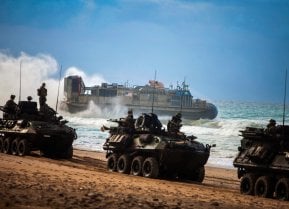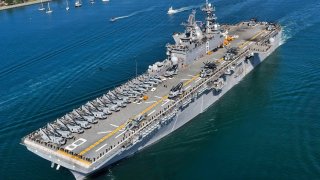The U.S. Navy's Wasp-Class Assault Ships are Mini Aircraft Carriers
For over thirty-five years, the Wasp-class vessels have remained the U.S. Navy’s large-deck multipurpose amphibious assault ships. As of 2024, seven Wasp-class ships are still commissioned.
For more than thirty-five years, the Wasp-class vessels have remained the U.S. Navy’s large-deck multipurpose amphibious assault ships. As of 2024, seven Wasp-class ships are still commissioned.
The Wasp-class was designed as a follow-up to the Navy’s earlier Tarawa-class assault ships.
These landing helicopter dock (LHD) vessels are capable of transporting nearly the full strength of a U.S. Marine Corps Marine Expeditionary Unit. Notably, the Wasp ships were the first to be specifically designed to employ air-cushion landing craft and to carry Harrier II AV-8B short take-off vertical landing jets.
The history of the Wasp-Class ships
A modified version of the Tarawa-class amphibious assault ships, the Wasp-class’ design was uniquely constructed for the operation of Landing Craft Air Cushion hovercraft and the AV-8B Harrier II aircraft. Manufacturer Ingalls Shipbuilding constructed each ship in this class in Pascagoula, Mississippi. The lead ship in the class, USS Wasp (LHD-1), was the first to commission in 1989, followed by USS Essex (LHD-2), USS Kearsarge (LHD-3), USS Boxer (LHD-4), USS Bataan (LHD-5), USS Bonhomme Richard (LHD-6), USS Iwo Jima (LHD-7) and USS Makin Island (LHD-8). In 2020, USS Bonhomme Richard was seriously damaged following a fire and was decommissioned the following year.
How are the Wasp ships different from the Tarawas?
Unlike the Tarawa-class ships, the Wasp vessels were designed with a lower placement of the ships’ bridges and a relocated command and control facilities. Additionally, the Tarawa’s 5-inch Mk 45 naval guns were moved on the Wasps and roughly 24 extra feet were constructed to better equip the LCACs. The Wasp vessels can lug a variety of assault helicopters, plus up to eight Harriers for close air support. As detailed by Naval Technology, “A typical mix of helicopters is 12 CH-46 Sea Knight, four CH-53E Sea Stallion; three UH-1N Huey and four AH-1W Super Cobra helicopters. USS Boxer (LHD 4) became the first ship to deploy the new four-bladed UH-1Y helicopter in October 2008. The vessels are also able to embark the MV-22 Osprey tilt-rotor aircraft.”
Wasp-Class: Specs & Capabilities
The Wasp-Class assault ships are also well-equipped in terms of armament. The first four Wasp ships possess two Mark 29 octuple launchers for RIM-7 Sea Sparrow missiles, three Phalanx CIWS, two Mark 49 launchers for RIM-116 Rolling Airframe Missiles and eight guns.
Every ship in this class features an array of countermeasures as well, including Mark 36 SRBOC chaff and decoy launchers, a Sea Gnat missile decoy, an AN/SLQ-25 torpedo decoy and an AN/SLQ-32 Electronic Warfare Suite. Two steam propulsion plants power the Wasp amphibious assault ships, generating a total of 400 tons of steam per hour and 70m000 shaft horsepower. These specs allow the vessels to sail at speeds in excess of 22 knots.

Throughout their three decades-plus in service, the Wasp-Class ships have participated in Operation Restore Hope in Somalia, Operation Enduring Freedom, and Operation Iraqi Freedom. These vessels may be aging. However, they continue to play a critical role in service with the Navy.
About the Author: Maya Carlin
Maya Carlin, National Security Writer with The National Interest, is an analyst with the Center for Security Policy and a former Anna Sobol Levy Fellow at IDC Herzliya in Israel. She has by-lines in many publications, including The National Interest, Jerusalem Post, and Times of Israel. You can follow her on Twitter: @MayaCarlin.
Image Credit: Creative Commons.


